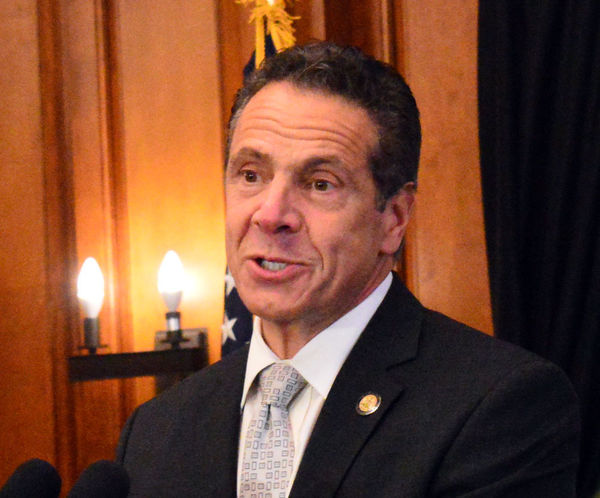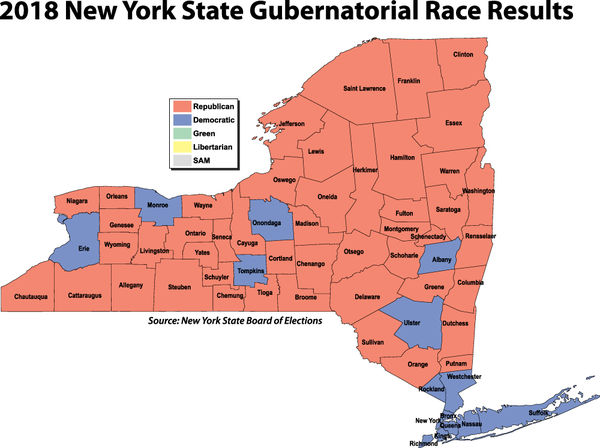New York Gov. Andrew Cuomo wins third term

Gov. Andrew Cuomo speaks in Saranac Lake in August. (News photo — Aaron Cerbone)
NEW YORK – Democrat Andrew Cuomo easily defeated Republican challenger Marc Molinaro on Tuesday to win a third term and an opportunity to create a legacy as one of New York’s longest-serving and most dominant governors.
Cuomo had sought to portray his opponent, the county executive of Dutchess County, as an extreme conservative and repeatedly mocked him as a “Trump Mini-me.” It was a successful tactic in a state where registered Democrats outnumber Republicans by more than 2-1 and where the president remains largely unpopular.
He offered relatively few new proposals for a third term, instead touting his work to rebuild bridges and airports, lower taxes, increase the minimum wage, jumpstart the upstate economy and take on Albany’s reputation for dysfunction. He also vowed to continue his work to push back against Washington.
“The president’s calculus is wrong,” Cuomo told supporters at his election night party in Manhattan. “Today’s election made clear that New York is not buying what President Trump is selling. We know his type too well … He uses fear and division to separate Americans. He preaches that diversity is the enemy … But we don’t fear diversity we celebrate diversity.”
Cuomo is the 10th governor in New York to secure a third term, joining the likes of DeWitt Clinton, Al Smith, Nelson Rockefeller, George Pataki and his own father, the late Mario Cuomo. He had been considered a likely presidential contender in 2020 until he vowed this year to serve an entire four years if re-elected.

Democratic New York Gov. Andrew Cuomo won majorities in New York City, Long Island and most upstate cities while Republican Marc Molinaro won in the rest of upstate. (News graphic — Steve Bradley)
Third terms proved difficult for former governors as staff turns over, critics grow bolder and voters become fatigued. New York City’s antiquated subway system, in need of billions of dollars in upgrades, is likely to pose a significant challenge. Other issues looming for the governor include proposals to legalize recreational marijuana, continuing struggles for the upstate economy, a dearth of affordable housing and a divisive political climate that has exposed fault lines between liberals and moderates within his own party.
Cuomo significantly out-fundraised Molinaro and had more than 40 times his rival’s financial resources in the homestretch of the campaign. Throughout the race he maintained a big lead in the polls, which found that Molinaro remained largely unknown to many voters.
Molinaro, who has said he didn’t vote for Trump, tried unsuccessfully to focus the race on Cuomo’s eight years as governor, arguing the governor had failed to address rampant political corruption, New York City’s aging subways or the upstate economy. He also vowed to work with both parties and eschew Cuomo’s often hard-charging brand of governing. But his campaign struggled to broadcast his message in a contentious midterm election in which national politics dominated.
“I challenge Gov. Cuomo to work with all those New Yorkers who feel like they are on the outside looking in,” Molinaro said in his speech concession speech.
As he did during his primary battle with former “Sex and the City” star Cynthia Nixon, Cuomo campaigned as a pragmatic leader who values action over rhetoric. He touted his administration’s work to overhaul airports and train stations in New York City, build a replacement for the Tappan Zee Bridge and pass gun control, a higher minimum wage, same-sex marriage and income tax cuts.
Three third-party candidates placed far behind Cuomo and Molinaro in Tuesday’s voting: Green Party candidate Howie Hawkins, independent Stephanie Miner and Libertarian Larry Sharpe.
Cuomo’s running mate, Kathy Hochul, will serve a second term as the state’s lieutenant governor. In New York candidates for the job of the state’s No. 2 executive run alongside candidates for governor. Hochul is a former Congresswoman from Buffalo who replaced former Lt. Gov. Bob Duffy as Cuomo’s running mate four years ago.
In legislative races, while votes are still counted in some races, Democrats claimed victory in the state Senate, saying they expect to have a strong majority of the chamber’s 63 seats thanks to big wins on Long Island.
Republicans conceded the loss of what was their last grasp on power in state government. Democrats will now control the Assembly, the Senate and all four statewide offices.
“While tonight’s results are disappointing, the Senate Republican Conference will continue to be a strong and important voice in Albany,” Republican Senate Leader John Flanagan said. “When we need to push back, we will push back. And where we can find common ground, we will always seek it.”
Sen. Andrea Stewart-Cousins of Yonkers is now in line to lead the Senate when the Legislature reconvenes in January.
“We will finally give New Yorkers the progressive leadership they have been demanding,” she said in a statement.
In other statewide races, Democrat Tish James was elected attorney general, soundly defeating Republican Keith Wofford. James, now the New York City public advocate, will be the first woman elected attorney general and the first African American to serve as the state’s top law enforcement official. She’ll replace Barbara Underwood, who as appointed to fill out the term of Democrat Eric Schneiderman. Schneiderman resigned earlier this year after he was accused of assaulting four women he dated. He has denied the charges.
In the comptroller’s race, incumbent Democrat Tom DiNapoli as elected to another term as the state’s top financial watchdog, defeating Republican Jonatan Trichter.
—
Associated Press Writer Sabrina Caserta contributed to this report.
- Democratic New York Gov. Andrew Cuomo won majorities in New York City, Long Island and most upstate cities while Republican Marc Molinaro won in the rest of upstate. (News graphic — Steve Bradley)


